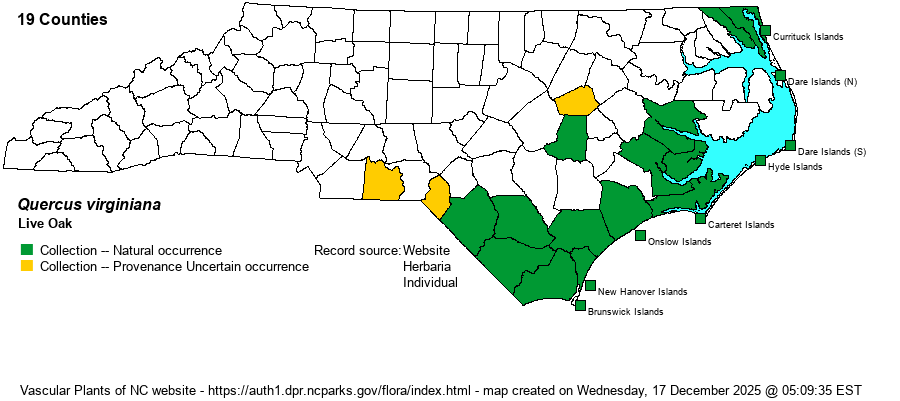| Author | P. Miller | |
| Distribution | Strictly in the Coastal Plain, and mainly along the coast. Ranges inland into the southern half of the province as far west as Wayne (disjunct on sandhills in the southeastern part of the county) and Robeson counties. A specimen for Wilson County is here placed as Provenance Uncertain owing to a scarcity or lack of natural "sandhill" habitat, it being found along a forest margin near a soccer field on a college campus. A specimen record for Orange County certainly relates to a planting or escape. A specimen from Anson County, in the eastern Piedmont, probably relates to a non-natural population. Reports on iNaturalist are not included here, as this species and many other oaks are often planted, as well as are frequently misidentified (or at least are difficult to confirm by photos only).
This Southern species ranges north to southeastern VA and OK, and south to essentially all counties bordering the Gulf Coast from FL to TX. It is essentially absent over most of NC, and nearly all of TN and AR.
| |
| Abundance | Common along the immediate coast, in maritime settings; reasonably common within about 10 miles of the coast, on the mainland. Farther inland, rare to uncommon and local in south-central counties. Despite an abundance of sand in the Sandhills, it is absent from this region (at least as natural occurrences). The SRANK of S3 underestimates the abundance of this species, especially as the much rarer Q. geminata is also given an S3 rank by NCNHP. Based on its much wider range in the state and its abundance within it, Q. virginiana should be given an S4 state rank. | |
| Habitat | This species is a dominant woody plant in coastal sands, forming maritime shrub thickets and is a key tree in maritime forests. Away from the coast, it is found typically on sand ridges -– such as fluvial sand deposits along rivers, but generally not on xeric sands in the Sandhills region. |
| Phenology | Flowers in April, and fruits from September to November of the same year. | |
| Identification | This very familiar tree is known for being one of the few trees with a broader crown than its height. It is a medium-height evergreen tree, though it rarely exceeds 60 feet tall; however, the crown in open areas can reach 80 feet or more in width. It has very thick, shiny dark green leaves above, evergreen (though dropping just as new leaves emerge in spring), and elliptical to somewhat obovate in shape. The margins are generally entire, and the margins are usually slightly rolled under. The leaves can be confused with the quite similar Sand Live Oak (Q. geminata), which can grow with it but is a smaller tree. The latter species has leaves greatly rolled under such that much of the lower surface is hidden (somewhat like a canoe), and the leaves have strongly impressed veins above, especially with a series of parallel veins that are perpendicular to the main leaf axis. In maritime forests, Darlington Oak (Q. hemisphaerica) can be common, along with Live Oak. This oak almost always has one to several shallow teeth (as it is a “red oak”) and the leaves are narrower, usually not showing rolled sides. Note that, when growing in a forest setting, Live Oak does not show nearly as wide spreading limbs that it does when in the open; thus, it can be more difficult to separate from other oaks when in a forest stand. | |
| Taxonomic Comments | Occasional references may list varieties or subspecies, and only in recent decades was Q. geminata split out of Q. virginiana as a valid species. RAB (1968), for example, had Q. geminata as being included within Q. virginiana.
| |
| Other Common Name(s) | Southern Live Oak, Coastal Live Oak. As “Live Oak” is a nested name, within Sand Live Oak (Q. geminata) and several Western species, it is probably best to use “Southern Live Oak” as the common name, at least eventually. Most references still say simply “Live Oak” -– the prevalent name found on websites and references. | |
| State Rank | S3 [S4] | |
| Global Rank | G5 | |
| State Status | | |
| US Status | | |
| USACE-agcp | FACU link |
| USACE-emp | FACU link |

